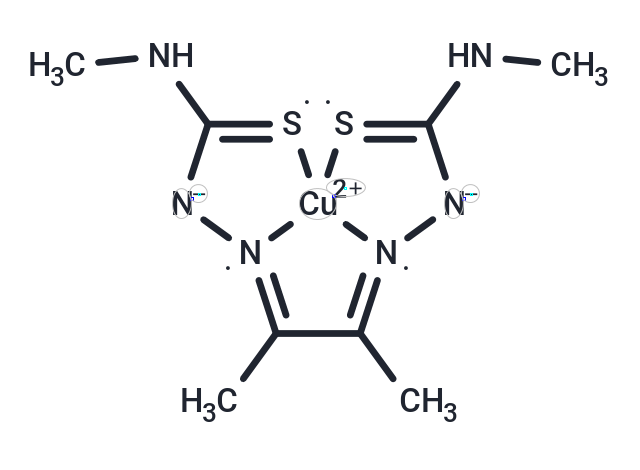- 全部删除
 您的购物车当前为空
您的购物车当前为空
CuATSM
The metallo-protein Cu/Zn-superoxide dismutase (SOD1) is a ubiquitous enzyme responsible for scavenging superoxide radicals. Mutations in SOD1, which alter its metal binding capacity and can result in protein misfolding and aggregation, have been linked to familial amyotrophic lateral sclerosis (ALS). Cu-ATSM is an orally bioavailable, blood-brain barrier permeable complex that has traditionally been used in cellular imaging experiments to selectively label hypoxic tissue via its susceptibility to reduction by oxygen-depleted mitochondria. More recently, Cu-ATSM has been reported to improve locomotor function and survival in a transgenic ALS mouse model by delivering copper specifically to cells in the spinal cords of mice producing misfolded SOD1 proteins. Copper chaperone for SOD (CCS) is presumed to utilize the copper from Cu-ATSM to prevent misfolding of the SOD1 protein.

CuATSM
The metallo-protein Cu/Zn-superoxide dismutase (SOD1) is a ubiquitous enzyme responsible for scavenging superoxide radicals. Mutations in SOD1, which alter its metal binding capacity and can result in protein misfolding and aggregation, have been linked to familial amyotrophic lateral sclerosis (ALS). Cu-ATSM is an orally bioavailable, blood-brain barrier permeable complex that has traditionally been used in cellular imaging experiments to selectively label hypoxic tissue via its susceptibility to reduction by oxygen-depleted mitochondria. More recently, Cu-ATSM has been reported to improve locomotor function and survival in a transgenic ALS mouse model by delivering copper specifically to cells in the spinal cords of mice producing misfolded SOD1 proteins. Copper chaperone for SOD (CCS) is presumed to utilize the copper from Cu-ATSM to prevent misfolding of the SOD1 protein.
| 规格 | 价格 | 库存 | 数量 |
|---|---|---|---|
| 2 mg | ¥ 447 | 5日内发货 | |
| 5 mg | ¥ 892 | 5日内发货 | |
| 100 mg | ¥ 8,150 | 6-8周 |
产品介绍
| 产品描述 | The metallo-protein Cu/Zn-superoxide dismutase (SOD1) is a ubiquitous enzyme responsible for scavenging superoxide radicals. Mutations in SOD1, which alter its metal binding capacity and can result in protein misfolding and aggregation, have been linked to familial amyotrophic lateral sclerosis (ALS). Cu-ATSM is an orally bioavailable, blood-brain barrier permeable complex that has traditionally been used in cellular imaging experiments to selectively label hypoxic tissue via its susceptibility to reduction by oxygen-depleted mitochondria. More recently, Cu-ATSM has been reported to improve locomotor function and survival in a transgenic ALS mouse model by delivering copper specifically to cells in the spinal cords of mice producing misfolded SOD1 proteins. Copper chaperone for SOD (CCS) is presumed to utilize the copper from Cu-ATSM to prevent misfolding of the SOD1 protein. |
| 分子量 | 321.92 |
| 分子式 | C8H14CuN6S2 |
| CAS No. | 68341-09-3 |
| 存储 | Powder: -20°C for 3 years | In solvent: -80°C for 1 year | Shipping with blue ice. |
| 溶解度信息 | DMF: 2 mg/mL (6.21 mM), Sonication is recommended. DMSO:PBS (pH 7.2)(1:9): 0.1 mg/mL (0.31 mM), Sonication is recommended. DMSO: 10 mg/mL (31.06 mM), Sonication is recommended. |





 还可以
还可以

评论内容